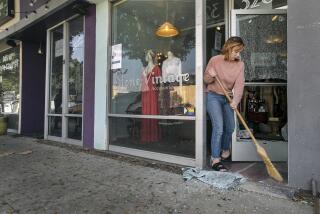Given $20 Million for Drug Enforcement <i> or </i> Treatment, I’d Choose . . . : . . . to refuse the choice. We must instead do more of both, from education to tough sentencing.
Recently The Times invited gubernatorial candidates Dianne Feinstein and Pete Wilson to participate in a number of issue discussions on this page. Today’s question is: You have $20 million in discretionary money, but you can only use it by spending all of it on more law enforcement, or all of it on new drug rehabilitation clinics. What is your choice and why? And, during the next administration or two can California develop, on a very large scale, effective alternatives to imprisoning so many people? What are the alternatives, and have they any real prospects of reducing criminality and the costs of crime, prosecution and punishment?
Topics to appear in the coming weeks will be the environment and education.
I would refuse to accept the hypothetical $20-million allocation to combat the drug traffic that spawns such incalculable tragedy and waste of human potential among California’s young, as well as the vast majority of violent crime suffered by Californians.
We must not make a false choice between law enforcement and rehabilitation. We must instead do more of both. How much better it is to prevent crime than to punish it. How much better to prevent drug use than to engage in the uncertain and expensive process of rehabilitation.
Here are some of the tools I would use:
Prevention through education. Some of the most effective preventive drug education programs--DARE and SANE, have been created by Los Angeles police agencies and schools. Their success is built upon teaching kids to so value themselves that they can repel the schoolyard drug dealers.
With proper reinforcement on a community-wide basis--like the volunteer-driven “Riverside Says No to Drugs” campaign--preventive drug education represents our best hope of curbing drug use.
Anti-drug programs in junior high schools should include field trips to neonatal intensive care units so that young boys and girls can see firsthand the horrible results of drug use during pregnancy.
Monies from Proposition 133 . This November measure would increase state sales taxes by one-half cent to generate, over five years, about $7.5 billion for anti-drug purposes. Under provisions of the previously approved Proposition 98, about $3 billion of Proposition 133’s funds would be allocated to schools. Even if we doubled anti-drug programs in every California school, the cost would be about $200 million over five years, a 1,500% increase. Proposition 133 thus is generous to a fault.
User accountability and mandatory rehabilitation . Far more in need of such generosity is a realistic program to get mothers of drug-addicted newborns “clean” and to provide the necessary care.
We must, in California and America, contain and reverse an epidemic of child abuse through the umbilical cord. Even alcohol and drug rehabilitation conducted in residential settings--costing thousands of dollars--entails far fewer costs in tax dollars than repeat deliveries of addicted babies--not to mention the human costs.
Crack cocaine is so fiercely addictive that most pregnant users are incapable of seeking help voluntarily. In many counties, Child Protective Services order them to undergo rehabilitation as a condition to regaining custody of their children. This compulsion is wise and fully justified. Society simply cannot let them continue using drugs during pregnancy and to produce new addicted and irreversibly damaged children.
Mandatory random drug testing of new drivers . We won’t win a war on drugs by pretending we can “punish the pushers” without holding users responsible for their choice. Just as we must hold accountable the pregnant user of drugs, so are we right to hold accountable young applicants who seek the legal privilege of driving the potentially lethal ton-and-half of steel we call a car.
First-time drivers’ license applicants would be subject to mandatory random drug testing within one year of license receipt. It will keep our kids and the rest of us alive--and help keep them drug-free.
Law enforcement and prison alternatives. While we must engage in preventive education, preventive rehabilitation of pregnant users, and prevention by imposing user accountability, we also have no choice but to intensify law enforcement efforts to interdict the flow of these poisonous drugs. As we seek to reduce demand, we must also keep up the pressure to reduce supply.
In the Senate I have sponsored a number of laws to curb drug use, to gain more help for local law enforcement and to help stop the flow of drugs across our borders. My legislative pro-law-enforcement record, my 11-year tenure as mayor of San Diego when it was ranked as the most crime-free big city in the state and my role in securing passage of Proposition 115 are among the reasons why I have won the endorsement of the California Narcotics Officers Assn. and almost every other major California major law enforcement organization.
These officers who daily risk their lives fighting drugs and crime are more impressed by performance than promises. They are entitled to the tools needed to do their jobs. Federal drug czar William Bennett recently stated that “California has the best cops--and the worst laws.”
The way to take the profit out of dealing is to dramatically increase the risks for the dealers. The way to change the odds to favor the citizen is to increase penalties for selling drugs. We must end the dangerous policy that frees the average convicted felon in California after he has served only half of the time sentenced. Those who would make money by making addicts of our kids are beneath contempt. Any adult who sells a dangerous drug to a minor within 1,000 yards of a school should receive an added 15 years on a basic tough sentence.
So, are there alternatives to simply locking up more people for drug violations? Sure.
Demand reduction and prevention of all sorts are the alternatives. So is an educational system that offers real hope to kids that hard work and learning and higher test scores justify high aspirations.
I would rather build physics labs than prisons. But letting crack sellers back on the street within 60 days costs us infinitely more in tax dollars and human suffering, in lost and wasted human potential, than prisons. Substantially increased sentences offer the hope to keep dealers away from our kids and deter kids from becoming the dealers.
More to Read
Sign up for Essential California
The most important California stories and recommendations in your inbox every morning.
You may occasionally receive promotional content from the Los Angeles Times.










